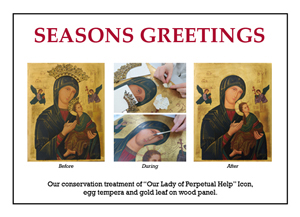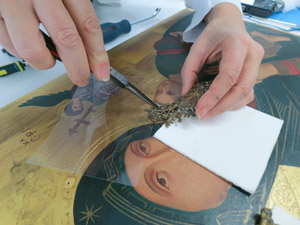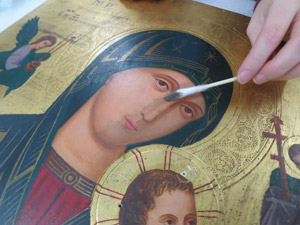Warmest Wishes This Holiday Season


Our holiday card this year shows the conservation treatment of an Icon of “Our Lady of Perpetual Help” (OLPH) belonging to a church of the same name in Vancouver. This 1948 artwork in tempera and gold leaf on a hardwood panel, is a copy of the original Byzantine icon held in Rome.

Father Rich Luberti of the OLPH Vancouver contacted FSR, noting that their icon was dirty and appearing duller over time, with some cracks and flaking paint that appeared unstable. The church clergy wished to have the painting cleaned, losses restored, and stabilized to ensure preservation into the future.
The icon was received in the lab with a jeweled crown applied on Mary’s and Jesus’ heads. The original icon also had these crowns placed by order of the Vatican in 1867, but they were removed when that icon underwent restoration in the 1990’s.

The icon is positioned in front of prayer candles so light soot does carry onto the painting, and yet the open exhibit is essential to the icon’s relationship to the prayer area. Our conservators cleaned the paint layer of dirt, soot and grime using an aqueous cleaning solution prepared in our lab. Previous restorations that were over-large and covering original paint were removed with organic solvents. The icon is now cleaner and appears much brighter. The removal of the post-production crowns has returned the work to its original appearance, and one that emulates the original icon in Rome.

The chips, tack holes from the removal of the crowns, and other areas of paint loss were consolidated using sturgeon glue through tissue, and inpainting was accomplished with conservation resin and pigments, with 24 K gold flakes to compensate for small areas of missing gilding. Larger areas of thinned gilding (from older cleaning attempts) were left alone so as to avoid re-gilding the icon background, and making it less original. But, missing flakes of the brown-red inscriptions at the top corners were important to the interpretation of the icon and were compensated by following a detailed image of the original icon. As is ethical and standard in our lab, all infilling and inpainting of the small areas of paint loss, chips and gouges was kept within the borders of the losses and does not cover any of the artist’s work, thus revealing all of the image possible. To protect the surface from grime and the soot from nearby candles, the custodians asked that a thin protective varnish be applied. A thin layer of easily removable conservation varnish was applied in a mist application providing an invisible layer that does not detract from the immediacy of the painting surface. The conservators prepared a follow-up report with recommendations for safe lighting and display conditions when planned renovations of the church take place.
